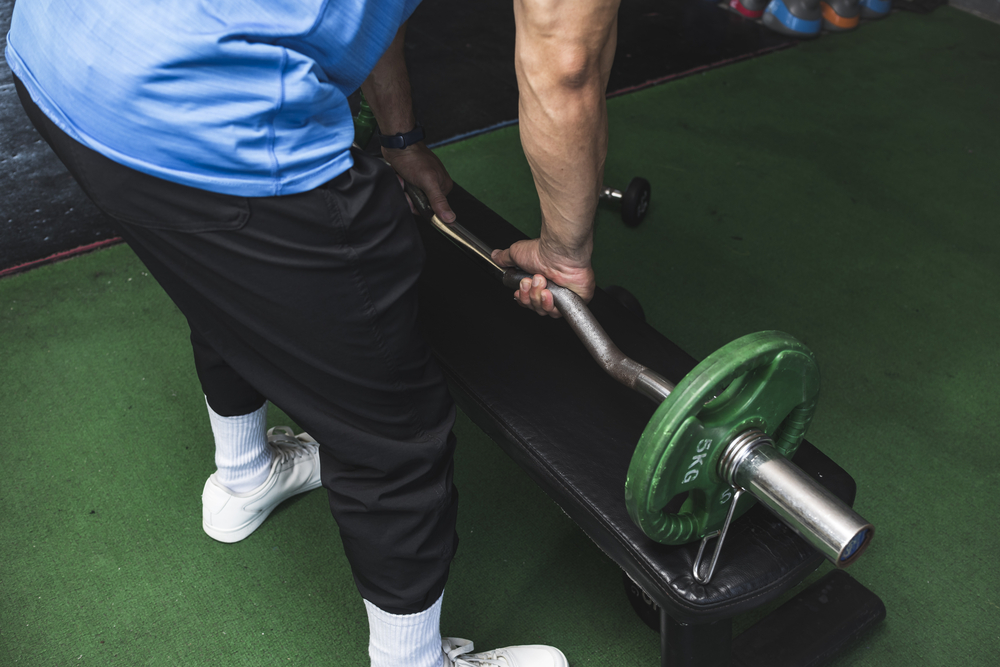There are many bicep curl variations such as hammer curls, preacher curls, drag curls, zottman curls, and spider curls.
Most have some clear differences when compared to the other variations, but sometimes, two bicep curl variations can be quite similar.
One example of this is barbell curls and reverse barbell curls.
Even from their names, you can tell they’ll likely be similar in many ways but there are some differences between them.
In this article, we compare barbell curls and reverse barbell curls to see if one is better than the other, or if these are two similar exercises that can fit nicely into your training program.

What’s The Difference Between Barbell Curls And Reverse Barbell Curls?
Standard barbell curls use a supinated grip (palms up) whereas reverse barbell curls use a pronated grip (palms down).
From a distance, you may not be able to tell if someone is performing barbell curls or reverse barbell curls as they look very similar.
However, once you get closer you will be able to tell which exercise they are doing simply by seeing what grip they are using on the bar.
Which Is Better For Building Biceps?
Both barbell curls and reverse barbell curls help build your biceps.
Standard barbell curls do a better job of making your biceps work harder though.
Your biceps have to do quite a bit of work during barbell curls as they’re placed under stress for a lot of the exercise.
While other muscle groups can come into play, barbell curls are predominantly done by your biceps.
Which Is Better For Building Forearms?
The change from a palms-up grip to a palms-down grip actually makes quite a big difference as to the muscles worked in reverse barbell curls.
Reverse barbell curls work your forearm muscles more resulting in potentially bigger forearms and a stronger grip.
This makes sense if you think about it.
Gravity is trying to pull the barbell down towards the ground.
The only way it’ll stay in your hands is by you gripping it tightly.
The pronated grip makes this much harder so more muscles are needed to activate, including those in your forearms.
Difficulty Level
Barbell Curls
Barbell curls have a relatively low difficulty level.
Considering the movement is all based on flexion of the elbow, there aren’t too many points where things can go wrong.
That being said, the technique is very important and errors can be made by bringing your shoulders into the movement too much, or by swinging and arching your back to generate momentum.
The technique may potentially cause some issues but the movement itself is pretty easy to perform.
Reverse Barbell Curls
Reverse barbell curls are quite a challenging exercise.
You have to hold the bar in a much weaker position and this can put a lot of stress on your lower and upper arm muscles.
The Verdict
Barbell curls and reverse barbell curls rely on flexion of the elbow to perform the movent needed in each exercise.
The pronated grip used in reverse barbell curls makes them a harder exercise to perform.
The weaker grip position and increased effort level required to keep the bar in the right place throughout the exercise can be a big challenge.
Ease of Access
Barbell Curls
As a barbell and weight plates are all that you need to do barbell curls, they’re a very accessible exercise.
Most gyms have a range of barbells and weight plates so finding the equipment you need for barbell curls should be easy.

Reverse Barbell Curls
To add reverse barbell curls into your arm workouts, all you need is a barbell and weight plates.
As these are readily available, reverse barbell curls have great ease of access.
The Verdict
As both barbell curls and reverse barbell curls only require a barbell and weight plates to perform, both are very accessible exercises.
If you train in a gym, you’ll likely have access to a range of barbells and weight plates which makes finding what you need even easier.
Variability
Barbell Curls
Changing the width of your grip on the barbell is a great way of targeting different parts of your biceps during barbell curls.
Using a grip wider than shoulder-width tends to work the short head of your biceps more.
The short head is the part of your biceps that gives the muscle width.
If you’re looking for thicker arms, then wide grip barbell curls could be a great choice.
Using a narrower grip on the bar during barbell curls activates the long head of your biceps more.
As the long head is responsible for your biceps peak, close-grip barbell curls can give you some bulging biceps.
Reverse Barbell Curls
As reverse barbell curls are so similar to standard barbell curls, changing the width of your grip also benefits different parts of your biceps.
You could also do reverse barbell curls using an EZ bar instead of a standard barbell.
This can challenge the working muscles a little bit more and also give you more control over the weight, as EZ bars tend to be a bit smaller than standard barbells.
The Verdict
There’s no clear winner when it comes to variability as both barbell curls and reverse barbell curls offer good levels of variation.
Changing the width of your grip or moving to an EZ bar can be ways of varying both exercises and keeping your workouts exciting and fresh.
Barbell Curls vs Reverse Barbell Curls: Which Is Better?
It’s extremely difficult to say whether one of these exercises is better than the other as they’re both very similar.
Reverse barbell curls are slightly harder to do as the grip used puts you in a weaker position.
Your forearms activate more though which counteracts some of the added difficulty.
Standard barbell curls put more focus on your biceps without bringing too many other muscles into the movement.
This can be useful if you’re keen to work your biceps in isolation.
Ultimately, you’ll probably have one exercise you prefer more than the other.
Barbell curls and reverse barbell curls are both fantastic arm-building exercises so whichever one you choose will be a positive addition to your training.
Sources
I’ve been in the fitness and strength training industry for nearly a decade. In that time, I’ve gained 30 pounds of muscle, written hundreds of articles, and reviewed dozens of fitness supplements. As for my educational background, I’m a currently studying for my Active IQ Level 3 Diploma in Personal Training.

